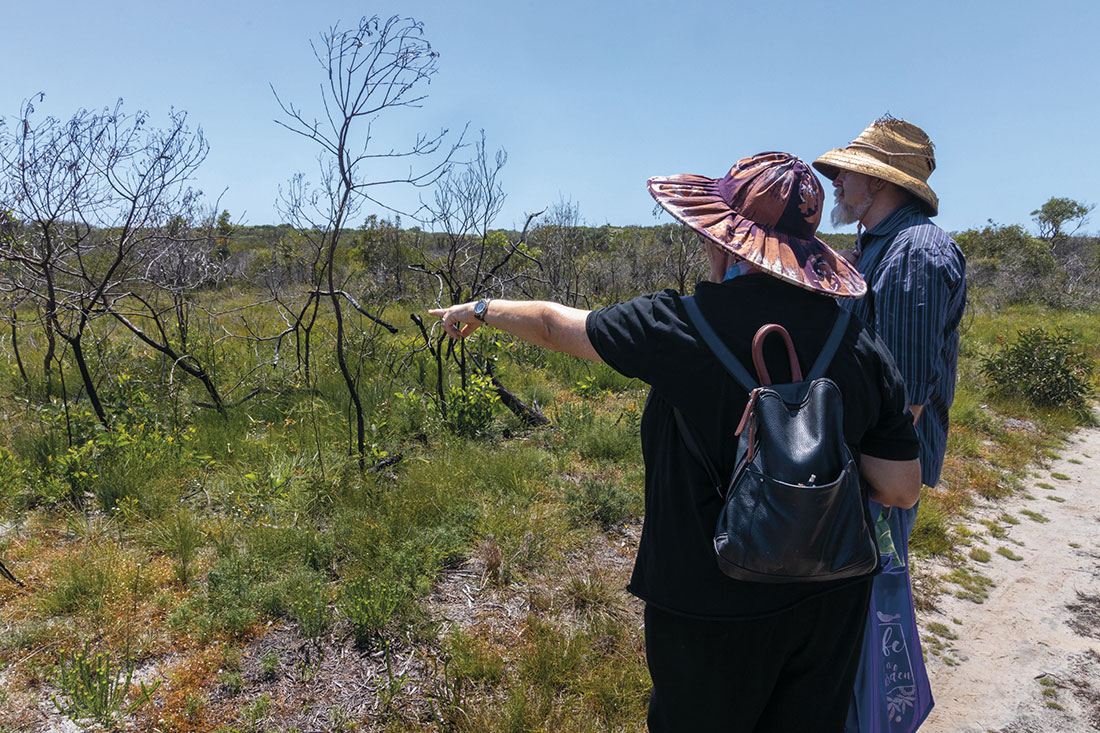
Where the Wildflowers Grow
You might not know it but wildflowers bloom across the region. Georgia Beard meets the Wild/flower Woman using Wildflower Walks to connect us with our native flora in ways we never have before.
Rooted in the sandplains of Currimundi, stunted trees and shrubs grow in burnt-green sprawls. Sunlight falls upon the leaves and a breeze rolls in off the river. Sometimes, you can hear the trills of birds and insects from deep in the scrub.
This is the wallum, low heathlands rich in plant and animal life stretching behind our south-east Queensland shores.
Early morning, I meet with a group to explore a small remnant of the wallum that once flourished over Kawana’s coastline – the Currimundi Lake (Kathleen McArthur) Conservation Park.
Guided by Dr Sue Davis, founder of the Wild/flower Women initiative and recipient of an Order of Australia Day Medal for 2022, we set off on her first Wildflower Walk for the year.
At first glance, the reserve looks like nothing more than a spread of leafy undergrowth. However, if you look closer, you’ll find speckles of delicate colours lining the heath trails.
Luckily, Sue’s keen eyes know what to look for, and she points out blooms you hadn’t noticed. After a while, you learn to look where she does, and soon you’re pointing out wallum banksias, speckled hyacinth orchids and a rare spray of flame-coloured Christmas bells.
As the former chair of Noosa Biosphere and a former creative arts lecturer at CQUniversity, Sue united her love for nature and the arts to create her passion project, Wild/flower Women.
The initiative encourages locals and visitors alike to learn about, nurture and protect our native wildflowers and environments.
Sue’s passion for ‘wildflowering’ came after her first wildflower walk as part of the Sunshine Coast Wildflower Festival.
Her curiosity deepened when she discovered the work of earlier ‘wild women’ including artist, author and conservationist Kathleen McArthur and poet Judith Wright.
“Back in the 1950s and 1960s, these women became involved in public campaigns to get national parks and reserves established,” she says. “I’ve always been interested in the environment, but Wild/flower Women is also about taking the stories of these women back to the region and celebrating their work.”
In 1953, Kathleen and Judith embarked on their first wildflowering expeditions, recording and painting the native wildflowers from Caloundra to Cooloola.
Their idea for a national park sparked on top of Mount Tinbeerwah, where the women stopped to look across the untouched plains of Cooloola.
While publishing floral illustrations in books and columns, Kathleen along with Judith founded the Wildlife Preservation Society of Queensland in 1962 with naturalist David Fleay and founder of Jacaranda Press, Brian Clouston. This society became instrumental in its campaigns to preserve Cooloola’s high dunes, heathlands and forests.
As sand mines and developments threatened the region, Kathleen and her supporters voiced their opposition and after years of campaigning, Cooloola National Park was established in 1975 and is now known as Cooloola Recreation Area, Great Sandy National Park.
Kathleen’s conservation commitment didn’t stop there. In later years, she identified land parcels she believed were valuable and worth protecting, including the Kathleen McArthur Conservation Park, posthumously renamed in her honour in 2003.
Like Kathleen, Sue believes protecting our local environments can give us a sense of respect for country and a knowledge of our natural heritage.
“There is this incredible diversity most of us have no idea about,” she says. “If you don’t know it, you don’t care about it, you don’t love it, you won’t want to protect it and then we lose it.
“If we recognise what belongs to these areas, we’ll be able to protect, restore and revegetate environments.”
Sue’s Wildflower Walks recapture the essence of Kathleen McArthur’s wildflowering expeditions, sharing how exploring country is just as valuable to us as it is to our ecosystems.
“During these bleak times, one of my great sources of solace and inspiration has been walking in these sorts of environments,” she says. “The experience of walking in the wallum is about connection to place and enjoying time out with nature.
“It provides ways for people to get to know more of these special environments – not only those who’ve lived here for a long time but for people who are new to the area. I’m seeing second and third generations of people, who I introduced to the wallum and wildflowering, taking their friends and family members. It’s nice to see it ripple out.”
Sue plans to expand the initiative by pairing wildflower walks with creative workshops, where participants can experience art in nature through drawing or photography.
“I’m hoping to do monthly walks in different locations even if they’re not during peak flowering times, because I find it quite fascinating to see how the environment changes over the seasons,” she said. “You shouldn’t have big expectations when you go on a walk as there might only be a few flowers out.
“Just try to appreciate them, value the experience of being in nature and hopefully, you’ll learn something.”
To embark on a Wildflower Walk, go to www.wildflowerwomen.com.au
WILDFLOWER WALKS
Wildflowering and en plein air morning with Dr Sue Davis
Saturday 2 April, 9am – 11.30am Mooloolah River National Park,
Claymore Rd, Sippy Downs
Watercolour wanderings with Libby Derham
Thursday 21 April, 9am – 11.30am
Emu Mountain, Havana Road East,
Coolum Beach
Book your Wildflower Walk, discover
new events and find out more at
www.wildflowerwomen.com.au



